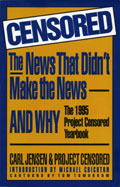
Censored: The News That Didn't Make The News - And Why
The 1995 Project Censored Yearbook
Jensen, Carl, and Project Censored. Introduction by Michael Crichton. Cartoons by Tom Tomorrow.
Publisher: Four Walls Eight Windows, New York, USA
Year Published: 1996
Pages: 332pp Price: $20.95 Resource Type: Book
Cx Number: CX8348
Documenting how the U.S. mass media does a shabby job, deliberately or negligently withholding information of vital importance.
Abstract:
At the heart of Project Censored lies a conviction that the U.S. mass media does shabby service to the citizenry, deliberately or negligently withholding information of vital importance. For the purposes of the Project, censorship was defined as "the suppression of information, whether purposeful or not, by any method - including bias, omission, under-reporting, or self-censorship - which prevents the public from fully knowing what is happening in the world."
Each year, Project Censored produces reports citing what are considered the top 10 underpublished stories of the previous year, as Jensen says in the current report "the stories that many Americans have not seen or hear about - but should have."
The main aim, says Jensen, is to stimulate journalists, editors, producers and publishers to support more muckraking investigative journalism, to act as the "irritating grain of sand" that makes oysters produce pearls.
Why do the media fail to cover critical issues consistently and comprehensively? Jensen argues it's not a conspiracy on the part of the media elite, though noting that currently fewer than 20 corporations control most of the mass media.
"Nonetheless, the bottom line explanation for much of the censorship that occurs in the mainstream media is the media's own bottom line. Corporate media executives perceive their primary, and often sole responsibility to be the need to maximize profits, not, as some would have it, inform the public. Many of the stories cited by Project Censored are not in the best financial interests of publishers, owner, stockholders, or advertisers.
Equally important, investigative journalism is more expensive than the 'public stenography' school of journalism. And, of course, there is always the 'don't rock the boat' mentality which pervades corporate media boardrooms and filters on down to the newsroom."
There are other "filters" to block certain issues from the main media advanced in the PCC yearbook including:
- the culture of journalism, that sees journalists sharing a point of view that is oblivious to the concerns of working people and other socially marginalized persons;
- the economics of news that sees newsroom staffs shrinking and investigative reporting too expensive;
- a reliance on official sources, that sees the powerful and the privileged getting "over-access" to the media while stories that may run against the grain of those sources are excluded;
- pack journalism that sees the media playing it safe with "follow-the-leader" coverage;
- technology that sees, as Neil Postman postulates, television with its "no-picture-no-go" gospel dominating and shaping the very nature of what is news.
The Yearbook includes a useful "eclectic chronology of Censorship from 605 B.C. (. . . Jehoiakim, the king of Judah, burned Jeremiah's book of prophecies . . .) to 1995 ( . . .Random House announced it would publish A Long Fatal Love Chase, a novel by Louisa May Alcott that had been censored more than a century earlier for being too sensational.)"
Also listed with summaries in each case are 1994's 20 top censored books (all published but with little notice) and the top 10 "junk food" news stories, topped, of course, by the O. J. Simpson case and including among other showbusy items "the British royals."
Both the U.S. and Canadian Yearbooks include synopses of all the selected shortlist stories (25 and 17 respectively) and in the U.S. edition the top stories are printed in full, as originally published.
Alternative media resource guides are included as appendice. The book offers 25 pages of listings including broacast and film, electronic new services, periodicals, libraries, columnists and news services.
The Top 10 U. S. Censored Stories of 1995
1. Unfinished Business -- Occupational Safety Agency keeps 170,000 exposed workers in the dark about health risks incurred on the job. Source: Health Letter.
2. Right-Wing Confidential -- The Council for National Policy (CNP), a powerful, virtually-secret organization of 150 ultra-conservative leaders is seen responsible for a sharp right turn in U.S. politics. Source: In These Times.
3. Flak for Defense Merger -- A secret Pentagon plan to subsidize mergers among defense contractors. Source: Newsday.
4. Poisoning Ourselves -- The impact of incineration on food and human health. Source: Government Accountability Project.
5. Full of Holes -- Clinton's retreat on the ozone crisis. Source: In These Times.
6. Protecting Government Against the Public -- 1947 AEC memo reveals what human radiation experiments were censored. Source: Secrecy and Government Bulletin.
7. Special Report: A Farewell to Fish? -- 60 billion pounds of fish wasted annually. Source: Mother Jones.
8. Why Don't We Stop Tuberculosis? -- TB has surged back and now kills more people than any other infectious or communicable disease in the world. Source: World Watch.
9. Project HAARP -- The Military's plan to alter the ionosphere. Source: Earth Island Journal.
10. Crimes Against Women -- Media part of problem for masking violence in the "language of love." Source: USA Today.
Subject Headings


